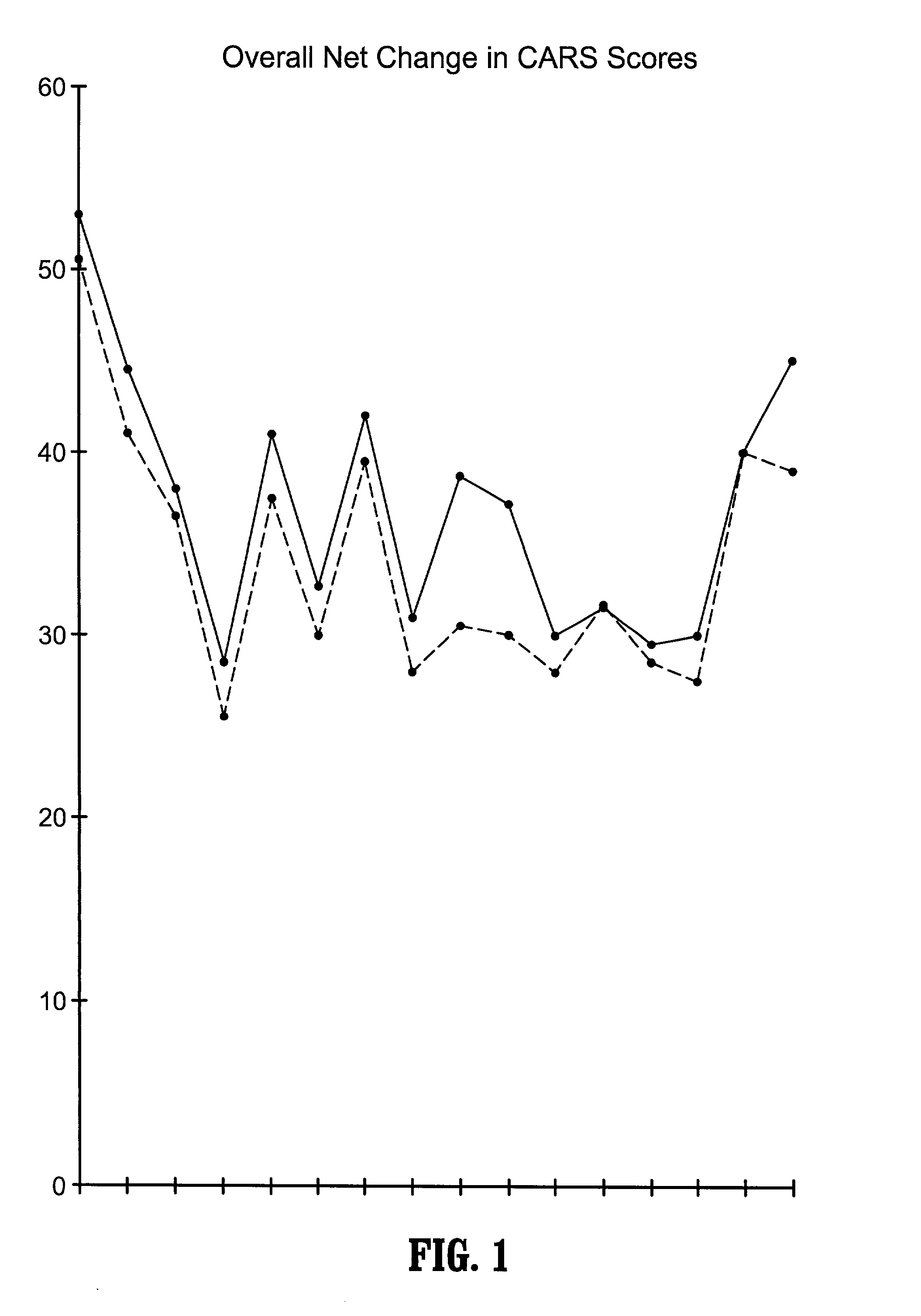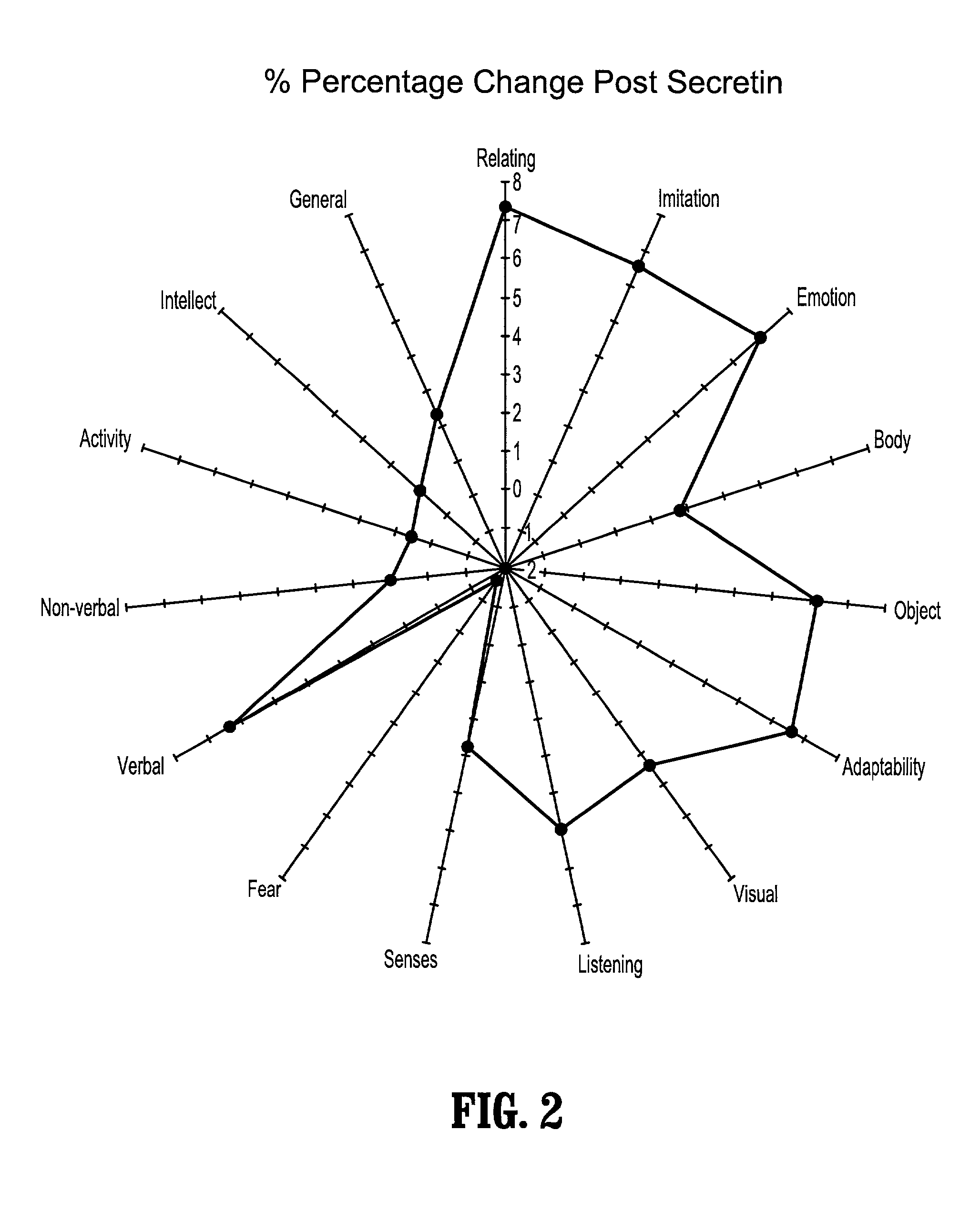Methods of treating pervasive development disorders
a technology of development disorders and fecal samples, applied in the field of methods of treating pervasive development disorders, can solve the problems that none of the known methods have tested fecal samples in determining the benefits of administering secretin, other neuropeptides, peptides and/or digestive enzymes to individuals suffering from pdd, etc., to achieve the improvement of protein digestion, promote normal growth and development, and improve the effect of fecal digestion
- Summary
- Abstract
- Description
- Claims
- Application Information
AI Technical Summary
Benefits of technology
Problems solved by technology
Method used
Image
Examples
experiment 1
[0046] Results of Experiment 1
[0047] The results of Experiment 1 are illustrated in FIGS. 1-14. For instance, approximately one week after the first secretin infusion, the fecal chymotrypsin level of each of the 16 autistic children was measured again. The results of this test are illustrated in FIG. 14. As shown, the chymotrypsin level of each of the 16 autistic children test increased post-secretin administration (as compared with the levels shown in FIG. 13).
[0048] In addition, FIG. 1 illustrates the pre-secretin CARS test results (solid line) and the post-secretin CARS test results (dotted line) for each of the 16 autistic children tested approximately 3 weeks after the first secretin administration. Most notably, FIG. 1 illustrates an overall decrease in the CARS scores indicating improvements in the PDD / autistic symptoms of the children. In particular, FIG. 2 illustrates respective percentage decreases in components of CARS scores, wherein the numbers represent percentage chan...
experiment 2
[0051] Results of Experiment 2
[0052] Out of the 37 autistic children tested, the fecal chymotrypsin levels of 34 children had returned to normal after 6 months, the fecal chymotrypsin levels of 2 children moved to equivocal, and the fecal chymotrypsin level of 1 child remained abnormal. These results of this experiment are listed in the following Table 1.
1TABLE 1 6 Months Post- Pre-Secretin Secretin Autistic Children Tested Administration Administration # Autistic Children w / Abnormal FC 37 1 levels # Autistic Children w / Equivocal FC 0 2 levels # Autistic Children w / normal FC 0 34 levels
[0053] III. Experiment 3
[0054] In this experiment, the fecal chymotrypsin levels of 28 children diagnosed with ADD were obtained using the fecal chymotrypsin test described above in Experiment 1. FIG. 15 illustrates the measured fecal chymotrypsin levels of these 28 children. It is to be noted that, as shown in FIG. 15, all of the 28 ADD children were found to have sub-normal fecal chymotrypsin lev...
experiment 3
[0056] Results of Experiment 3
[0057] At the time of this experiment, 4 out of the 10 children who were administered the digestive enzymes were taking Ritalin. As is known in the art, Ritalin is a stimulant medication used to treat children and adults with ADD and ADHD. More specifically, it is used to treat hyperactivity and attention problems. As a result of the administration of the digestive enzymes, all of the 4 children who had been taking Ritalin were able to completely stop taking the Ritalin. In addition, significant improvements in the behavior of the other 6 children were noted. These results are shown in the following Table 2:
2 TABLE 2 # ADD Children w / Sub-normal FC levels 28 # of the 28 ADD Children With Abnormal FC levels That 10 Were Administered Digestive Enzymes # of the 10 ADD Children That Were Administered Digestive 4 Enzymes Who Were Taking Ritalin # ADD Children Requiring Ritalin Administration 6 months 0 Post Administration of Digestive Enzymes
[0058] IV. Exper...
PUM
| Property | Measurement | Unit |
|---|---|---|
| Time | aaaaa | aaaaa |
| Time | aaaaa | aaaaa |
| Level | aaaaa | aaaaa |
Abstract
Description
Claims
Application Information
 Login to View More
Login to View More - R&D
- Intellectual Property
- Life Sciences
- Materials
- Tech Scout
- Unparalleled Data Quality
- Higher Quality Content
- 60% Fewer Hallucinations
Browse by: Latest US Patents, China's latest patents, Technical Efficacy Thesaurus, Application Domain, Technology Topic, Popular Technical Reports.
© 2025 PatSnap. All rights reserved.Legal|Privacy policy|Modern Slavery Act Transparency Statement|Sitemap|About US| Contact US: help@patsnap.com



